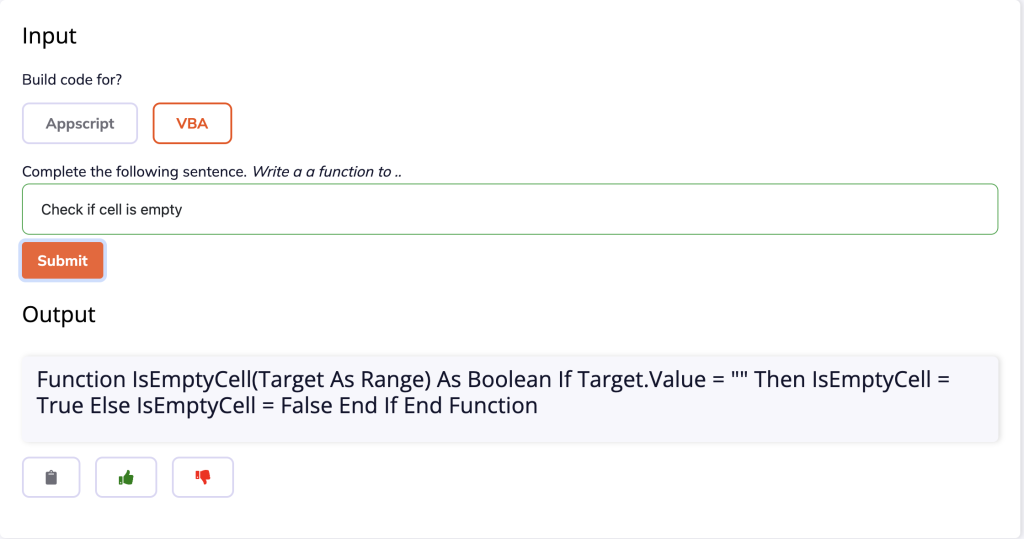Last Updated on 1 year by admin
How to write VBA Code in Excel the easy way with FormulaGenerator
Are you an Excel user looking for an easier way to write VBA code? If so, then you’ve come to the right place. FormulaGenerator is here to make writing VBA code in Excel a breeze.
Before we get started, we want to tell you that our AI can write VBA code from simple text instructions for FREE! No Coding required!
VBA or Visual Basic for Applications is a programming language used in certain Microsoft applications, including Excel. By using VBA you can create macros to automate tasks and run calculations on data. You can also make it easier for viewers to interact with your worksheet. Writing VBA code can be a daunting task, especially if you are not an experienced programmer.
So, let’s get started! The first step to writing VBA code in Excel is to understand the syntax and structure of the code itself.
Understanding the basics of VBA:
• Variables: Variables are used to store data and can be used in any part of your script. Variables can be declared and initialized with a value, or you can use them to store the results of a computation.
For example, look at this line of code:
Dim username As String
The “Dim” statement is most commonly used to declare variables. “username” is the variable name assigned by you and “String” is the variable type.
• Functions: Excel functions are pre-defined pieces of code that can be used to perform a specific task. For example, the “MsgBox” function can be used to display a message box on the screen. You either use one of the many existing Excel functions or define one on your own.
To give you an example:
Function sqr(Num As Double) As Double
sqr= Num*Num
End Function
Here, the “Function” statement is being used to create your own function. “sqr” is the user-defined name of the function. “Num” is the name of the variable that will be used within the function to arrive at a result. “Num” is being declared as Double type, and so is the output of the function.
The next line elaborates on what task the function should execute. Here, if you haven’t guessed already, we’re trying to find the square of a number. So we’re telling Excel to multiply the variable with itself whenever we use this function. And then, there’s the End Function statement.
• Control Structures: Control structures allow you to control the flow of your code, such as looping or branching. Through this, you give Excel the permission to do two things— make decisions, on the basis of certain criteria and repeat predefined tasks. For example, the “If…Then…Else” statement can be used to test a condition and execute code based on the result.
In short, the syntax of the above statement is as follows:
If <condition 1> Then
<command set 1>
Else
<command set 2>
End If
Here, if the first condition is true, the first set of commands will be executed. If it is false, the control will shift to the “else” part and the second set of commands will be executed.
• Object Models: Object models provide a way to interact with the objects in the Excel application, such as worksheets, ranges, and charts.
Once you understand the basics of the language, it’s time to start writing your script. To do this, you’ll need to open the Visual Basic Editor (VBE), which can be accessed from the Developer tab on the ribbon.
The Developer tab does not appear by default. You will have to right-click anywhere on the ribbon of tabs (Home, Insert etc.) and select Customize the Ribbon. Then check “Developer” in the panel on the right and click OK.
Inside the VBE, you can create a new module, which is where you’ll write your code. The VBE also provides tools to help you write and debug your code, such as the Immediate window and the Debug window.
You should also save your file as a .xlsm before starting to code.
At FormulaGenerator, we provide users with the ability to instantly get answers to spreadsheet questions using GPT, generate VBA or App script code from text descriptions, and get explanations of complex functions. So, if you’re looking for a way to learn how to write VBA code in Excel, then FormulaGenerator is the perfect solution for you.
If you like the example below, try creating your own VBA question using AI

